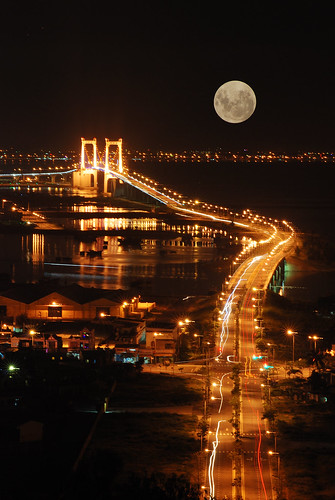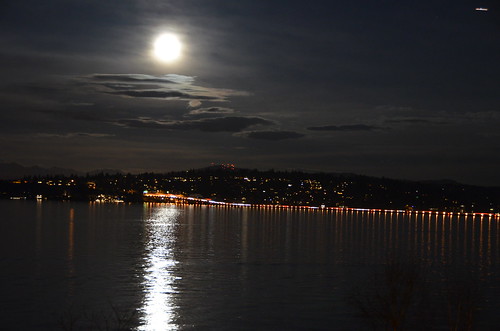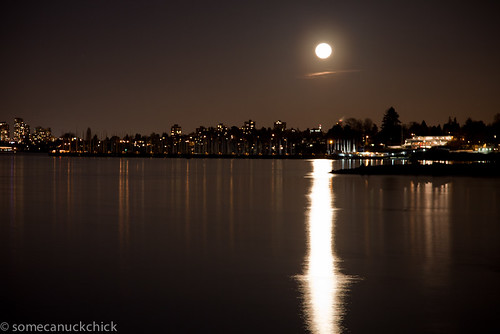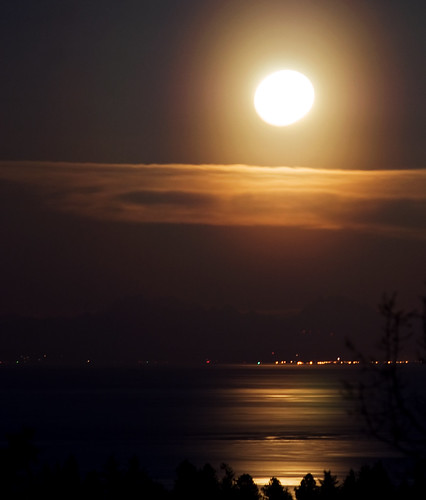Saturday night's "supermoon" appeared as planned, as the moon made its closest encounter to Earth since 1993. Full Moon really was a large Full Moon last night, reaching its exact full phase within an hour of lunar perigee, the point in the Moon's elliptical orbit closest to planet Earth.If you missed it, not to worry,have a look at these incredible supermoon photos from last night.
Supermoon
A "supermoon" is the coincidence of a full moon (or a new moon) with the closest approach the Moon makes to the Earth on its elliptical orbit, or perigee, leading to the technical name for a supermoon of the perigee-syzygy of the Earth-Moon-Sun system. The association of the Moon with both oceanic and crustal tides has led to claims that the supermoon phenomenon may be associated with increased risk of events such as earthquakes and volcanic eruptions. However, the evidence of such a link is widely held to be unconvincing.
The Moon's distance varies each month between approximately 357,000 kilometers (222,000 mi) and 406,000 km (252,000 mi) due to its elliptical orbit around the Earth (distances given are center-to-center).
The size and brightness of an object follows an inverse-square law, which means that a full moon at perigee is 12% larger and brighter than an average full moon. However, because the offset of the moon's orbit versus its phases is only two days, this change in appearance is gradual from month to month and therefore is not usually noticeable to a casual observer.
Terminology
The name SuperMoon was coined by astrologer Richard Nolle in 1979, defined as:
...a new or full moon which occurs with the Moon at or near (within 90% of) its closest approach to Earth in a given orbit (perigee). In short, Earth, Moon and Sun are all in a line, with Moon in its nearest approach to Earth.
The term supermoon is not widely accepted or used within the astronomy or scientific community, who prefer the term perigee-syzygy.[citation needed] Perigee is the point at which the Moon is closest in its orbit to the Earth, and syzygy is a full or new moon, when the Earth, the Moon and the Sun are aligned. Hence, a supermoon can be regarded as a combination of the two, although they do not perfectly coincide each time. Syzygy may occur within a maximum of 12 hours from perigee during a supermoon, and 1 hour from perigee during an extreme supermoon. (Wikipedia)
Supermoon
A "supermoon" is the coincidence of a full moon (or a new moon) with the closest approach the Moon makes to the Earth on its elliptical orbit, or perigee, leading to the technical name for a supermoon of the perigee-syzygy of the Earth-Moon-Sun system. The association of the Moon with both oceanic and crustal tides has led to claims that the supermoon phenomenon may be associated with increased risk of events such as earthquakes and volcanic eruptions. However, the evidence of such a link is widely held to be unconvincing.
The Moon's distance varies each month between approximately 357,000 kilometers (222,000 mi) and 406,000 km (252,000 mi) due to its elliptical orbit around the Earth (distances given are center-to-center).
The size and brightness of an object follows an inverse-square law, which means that a full moon at perigee is 12% larger and brighter than an average full moon. However, because the offset of the moon's orbit versus its phases is only two days, this change in appearance is gradual from month to month and therefore is not usually noticeable to a casual observer.
Terminology
The name SuperMoon was coined by astrologer Richard Nolle in 1979, defined as:
...a new or full moon which occurs with the Moon at or near (within 90% of) its closest approach to Earth in a given orbit (perigee). In short, Earth, Moon and Sun are all in a line, with Moon in its nearest approach to Earth.
The term supermoon is not widely accepted or used within the astronomy or scientific community, who prefer the term perigee-syzygy.[citation needed] Perigee is the point at which the Moon is closest in its orbit to the Earth, and syzygy is a full or new moon, when the Earth, the Moon and the Sun are aligned. Hence, a supermoon can be regarded as a combination of the two, although they do not perfectly coincide each time. Syzygy may occur within a maximum of 12 hours from perigee during a supermoon, and 1 hour from perigee during an extreme supermoon. (Wikipedia)
Image Veronique Renaud
Image Anthony Ayiomamitis
Image gienkhan
Image jonhohle
Image somecanuckchick
Image SouthIsland
Image SouthIsland
Image Veronique Renaud
Fan Art
ImageJD Hancock













Certainly the best moon shots - the Paris one is scary ! !
Relaxing...
Amazing moon photo´s and images! TY!
These are so beautiful.....................